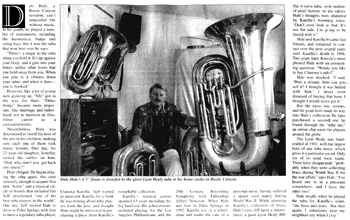"There's a magic in the tuba when you
hold it. It's up against your body, and it gets into your bones, unlike other horns
that you hold away from you. When you play it, it vibrates down your spine, and when
it does---you're hooked."
However, like a lot of young men growing up, "life" got
in the way for Hale. "Other things" became more important, like marriage
and fatherhood, not to mention an illustrious career as a cartoonist/writer.
Nevertheless, Hale was determined to instill his love of the
arts in his children, making sure each one of them took music lessons. One day, his
daughter, Jennifer turned the tables on him:"Dad, why don't you get back into music?
Hale obliged. He began playing the tuba again, this
time seriously enough to acquire five new "horns", six bands and a musical
circle of friends that included Jim Self, proclaimed "one of the best tuba player in
the world." One day, Self invited Hale to Fly to Palm Springs with him to meet
a legendary tuba player, Clarence Karella. Self wanted to interview Karella for a
book he was writing about tuba players from the past.
Karella's musical career spanned 63 years including big band
era. His achievements included playing for the Los Angeles Philharmonic and the 20th
Century Recording Symphony with Alfred Newman. While admiring Karella's collection
of brass, Hale's eyes fell upon a master-piece, a giant Lyon Healy BB-flat 4-valve tube,
with special mother-of-pearl buttons. Hale's thoughts were shattered by Karella's
booming voice. "Don't even look at that. I played it for 55 years and
it's my number one horn. It's not for sale. I'm going to be buried with
it." And he meant it.
Hale and Karella became fast friends, and remained in
contact over the next several years until Karella's death in 1996. Two years later,
Karella's sister phoned Hale with an astonishing question; "Would you like to
buy Clarence's tuba. He wanted you to be his first choice."
Hale was shocked. "I said, 'Wait a minute, how
can you sell it? I thought it was buried with him. I never even dreamed of
buying that horn. I thought I would never get it."
But his sister was serious, and the giant horn made its way
into Hale's collection. He later purchased a twin Lyon Healy, "Not as perfect
to look at but it also played like a dream."
The Lyon Healy were hand-crafted in about 1900-1904, with
the largest bore of any tuba made, which gives it a particular BOOMING sound. Only
six of its kind were made. Three have disappeared, "probably when they were
collecting brass during World War II for the war effort." says Hale. I've heard
one is in a museum somewhere, and I have the other two.
Hale recalls when he played the tuba for Karella's sister,
"she burst into tears. But then again, I sometimes hear my neighbors cry when I
play." |
